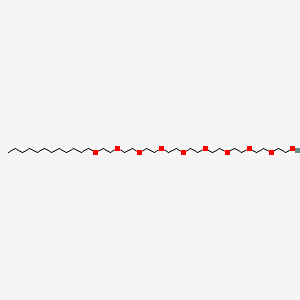



1. 3055-99-0
2. Nonaethylene Glycol Monododecyl Ether
3. 3,6,9,12,15,18,21,24,27-nonaoxanonatriacontan-1-ol
4. 9043-30-5
5. Laureth-9
6. Polyoxyethylene (9) Lauryl Ether
7. Polyethylene Glycol Monoisotridecyl Ether
8. Dodecyl Alcohol, Ethoxylated
9. Nonaoxyethylene Monododecyl Ether
10. Nonaethylene Glycol Monolauryl Ether
11. Polyoxyl 9 Lauryl Ether
12. 2-[2-[2-[2-[2-[2-[2-[2-(2-dodecoxyethoxy)ethoxy]ethoxy]ethoxy]ethoxy]ethoxy]ethoxy]ethoxy]ethanol
13. Chebi:46859
14. Ncgc00166290-02
15. Dodecyl Nona Ethylene Glycol Ether
16. Genapol X-080
17. Dodecylnonaglycol
18. Dsstox_cid_19721
19. Dsstox_rid_79436
20. Dsstox_gsid_39721
21. Asclera
22. Cas-3055-99-0
23. C12e9
24. Polydocanol
25. Aethoxy-sklerol
26. Polidocanol [inn:dcf:jan]
27. Einecs 221-284-4
28. Mfcd00043375
29. Poele
30. Varithena
31. Peg-9 Lauryl Ether
32. Macrogol 9 Lauryl Ether
33. Polydocanol; Thesit
34. Polyoxyethylen-9-laurylether
35. Aeo-9
36. Schembl25580
37. Chembl1231723
38. Dtxsid5039721
39. Polyoxyethylene Isotridecyl Ether
40. Amy22525
41. Zinc8214662
42. Tox21_112394
43. C12-e9
44. Polyethylene Glycol 450 Lauryl Ether
45. Akos028108701
46. Dodecylnonaoxyethylene Glycol Monoether
47. Tox21_112394_1
48. Db06811
49. Ncgc00166290-01
50. Ncgc00166290-03
51. Bs-51745
52. Hy-108294
53. Cs-0028163
54. N1204
55. F20806
56. Sr-01000944476
57. J-018016
58. Poly(oxy-1,2-ethanediyl),a-isotridecyl-w-hydroxy-
59. Sr-01000944476-1
60. Nonaethylene Glycol Monododecyl Ether, Nonionic Surfactant
61. Polyethylene Glycol Monododecyl Ether (average Polymer, N = 9)
62. Nonaethylene Glycol Monododecyl Ether [for Biochemical Research]
63. Polyethylene Glycol Monododecyl Ether (average Polymer, N = 9; Nonaethylene Glycol Monododecyl Ether)
| Molecular Weight | 582.8 g/mol |
|---|---|
| Molecular Formula | C30H62O10 |
| XLogP3 | 3.9 |
| Hydrogen Bond Donor Count | 1 |
| Hydrogen Bond Acceptor Count | 10 |
| Rotatable Bond Count | 37 |
| Exact Mass | 582.43429817 g/mol |
| Monoisotopic Mass | 582.43429817 g/mol |
| Topological Polar Surface Area | 103 Ų |
| Heavy Atom Count | 40 |
| Formal Charge | 0 |
| Complexity | 431 |
| Isotope Atom Count | 0 |
| Defined Atom Stereocenter Count | 0 |
| Undefined Atom Stereocenter Count | 0 |
| Defined Bond Stereocenter Count | 0 |
| Undefined Bond Stereocenter Count | 0 |
| Covalently Bonded Unit Count | 1 |
A randomized, open, multicenter study comparing the safety and efficacy of single or repeated endoscopic injection of Beriplast, a fibrin glue, with those of single endoscopic injection of 1% polidocanol (Aethoxysklerol) for the prevention of GI hemorrhage was conducted in 850 patients (ages 21-94 yr) with bleeding gastroduodenal ulcers. Recurrent bleeding rates among patients in whom the rates could be assessed were 58 of 254 in the polidocanol group, 51 of 266 in the fibrin glue single group, and 41 of 270 in the fibrin glue repeated group. The difference between fibrin glue repeated treatment and polidocanol was significant. Treatment failed, making other therapy necessary, in 34 of 261 in the polidocanol group, 34 of 274 in the fibrin glue single group, and 21 of 274 in the fibrin glue repeated group. The 30 day mortality rates were low in all groups. The safety profiles of the 3 treatments were similar.
Rutgeerts P et al; Lancet 350: 692-696 (1997)
Sclerosing Solutions; Tissue Adhesives; Detergents
National Library of Medicine's Medical Subject Headings online file (MeSH, 1999)
IN VARIOUS CONCN THESIT AND A MIXT OF SIMILAR ALKYL ETHOXYLATES KNOWN BY THE CODE NAME SCH 600 HAVE BEEN USED IN MAN AND ANIMALS FOR CORNEAL ANESTHESIA, FOR MUCOSAL ANESTHESIA PRECEDING ENDOSCOPY, FOR RELIEF FROM ITCHING (APPLIED LOCALLY TO THE ANUS, RECTUM, VAGINA, SKIN LESIONS, ETC), FOR NERVE BLOCKS (BY INFILTRATION), FOR SPERMICIDAL ACTIVITY (WHEN INSTILLED IN THE VAGINA), FOR RELIEF OF PAIN FROM PEPTIC ULCER (WHEN INGESTED).
Gosselin, R.E., H.C. Hodge, R.P. Smith, and M.N. Gleason. Clinical Toxicology of Commercial Products. 4th ed. Baltimore: Williams and Wilkins, 1976., p. II-180
MEDICATION (VET): PERFUSION OF ISOLATED GUINEA PIG HEARTS WITH POLIDOCANOL @ 20, 40, OR 100 UG DOSE-DEPENDENTLY DECR HEART RATE & CONTRACTILE STRENGTH & INCR ATRIAL REFRACTORY PERIOD. IN RATS, POLIDOCANOL INFUSION @ 10, 20, 30, AND 40 MG/KG DECR BLOOD PRESSURE & HEART RATE. DURING INFUSION, PQ INTERVAL OF THE ECG WAS ALSO PROLONGED. THESE CHANGES WERE DISCUSSED IN TERMS OF ITS USE FOR SCLEROTHERAPY OF PATIENTS WITH ESOPHAGEAL VARICES.
THIES E ET AL; CARDIAC EFFECTS OF POLIDOCANOL, A SCLEROTHERAPEUTIC DRUG- EXPERIMENTAL EVALUATIONS; CHIR FORUM EXP KLIN FORSCH 313 (1982)
For more Therapeutic Uses (Complete) data for DODECYL ALCOHOL, ETHOXYLATED (6 total), please visit the HSDB record page.
3. 3= MODERATELY TOXIC: PROBABLE ORAL LETHAL DOSE (HUMAN) 0.5-5 G/KG, BETWEEN 1 OZ AND 1 PT (OR 1 LB) FOR 70 KG PERSON (150 LB).
Gosselin, R.E., H.C. Hodge, R.P. Smith, and M.N. Gleason. Clinical Toxicology of Commercial Products. 4th ed. Baltimore: Williams and Wilkins, 1976., p. II-180
Polidocanol is a sclerosing agent indicated to treat uncomplicated spider veins and uncomplicated reticular veins in the lower extremity.
FDA Label
Polidocanol has a concentration and volume dependent damaging effect on the blood vessel endothelium.
C05BB02
S76 | LUXPHARMA | Pharmaceuticals Marketed in Luxembourg | Pharmaceuticals marketed in Luxembourg, as published by d'Gesondheetskeess (CNS, la caisse nationale de sante, www.cns.lu), mapped by name to structures using CompTox by R. Singh et al. (in prep.). List downloaded from https://cns.public.lu/en/legislations/textes-coordonnes/liste-med-comm.html. Dataset DOI:10.5281/zenodo.4587355
C - Cardiovascular system
C05 - Vasoprotectives
C05B - Antivaricose therapy
C05BB - Sclerosing agents for local injection
C05BB02 - Polidocanol
Absorption
When given intravenously, the maximum blood concentrations were reached in 15 mins.
Route of Elimination
Route of elimination was not indicated.
Volume of Distribution
When given intravenously, the volume of distribution was 35-82L.
Clearance
Sytemic clearance was 0.2-0.4 L/min.
Metabolism was not measured.
The half-life is approximately 1.5 h.
When administered, polidocanol locally damages blood vessel endothelium. Following the endothelial damage, platelets aggregate at the site and attach to the venous wall eventually resulting in a dense network of platelets, cellular debris, and fibrin that occludes the vessel. Eventually the vessel is replaced by connective fibrous tissue.